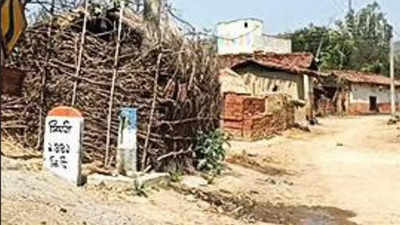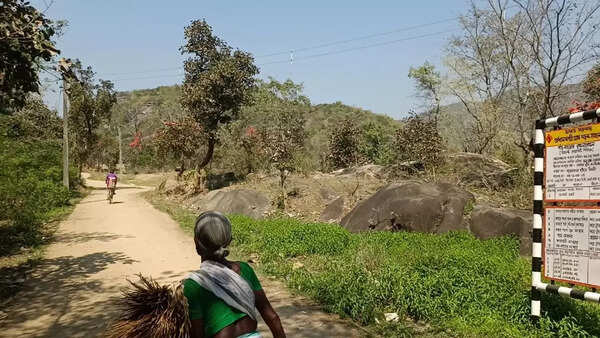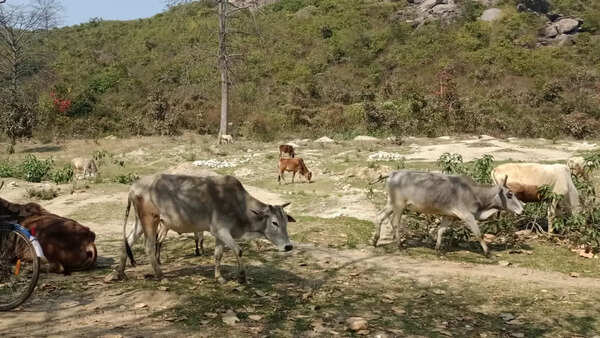- News
- City News
- kolkata News
- West Bengal: Livestock lost, but Purulia villagers keen to save leopard
Trending
This story is from March 13, 2022
West Bengal: Livestock lost, but Purulia villagers keen to save leopard
In 2015, when a leopard had strayed into a Purulia village, it was clobbered to death in front of cops and its mutilated carcass hung from a tree.

Simni village borders Kotshila forest range where the leopard has been spotted
PURULIA: In 2015, when a leopard had strayed into a Purulia village, it was clobbered to death in front of cops and its mutilated carcass hung from a tree.
Seven years down the line, another leopard has been spotted near Simni and Jabar villages that border Kotshila forest range in the district, but residents have resolved to protect the big cat despite loss of livestock, a paradigm shift in collective behaviour that may go a long way in curbing man-animal conflicts in the region.

"We are the ones encroaching on wildlife habitat in search of livelihood and not the other way round. The leopard has killed five calves raised by me, but I still don't want it to be killed or harmed," said Mokli Murmu, a resident of Simni who collects wood from the forest and sells it at a market 15km away for Rs 160 per 10kg.

Forest officials had set up five camera traps within a small radius of the spot where the half-eaten carcass of a pregnant cow was found recently. The cameras caught an adult leopard, which is believed to have come to Purulia from Hazaribagh National Park, Jharkhand, 180km away.

Villagers claim the big cat has been on the prowl in the area for a year and a half. It has fed on at least two dozen cows, goats and calves, they said. "Three weeks ago, I saw a big cat and a cub. First I thought it was a tiger, but later realised it may be a leopard," said one Prabhas Besra.

Chief wildlife warden Debal Roy said they were making public announcements to alert villagers. "We don't want anyone to panic or attack the animal like last time," he said.
Roy maintained that if the leopard had survived for nearly two years, it was likely that residents had become aware of wildlife conservation. "Also, if a leopard has had a cub here, it means it doesn't feel threatened. That is a great sign. We must still be on alert for the safety of both the animal and the villagers," he added.
Seven years down the line, another leopard has been spotted near Simni and Jabar villages that border Kotshila forest range in the district, but residents have resolved to protect the big cat despite loss of livestock, a paradigm shift in collective behaviour that may go a long way in curbing man-animal conflicts in the region.

"We are the ones encroaching on wildlife habitat in search of livelihood and not the other way round. The leopard has killed five calves raised by me, but I still don't want it to be killed or harmed," said Mokli Murmu, a resident of Simni who collects wood from the forest and sells it at a market 15km away for Rs 160 per 10kg.

Forest officials had set up five camera traps within a small radius of the spot where the half-eaten carcass of a pregnant cow was found recently. The cameras caught an adult leopard, which is believed to have come to Purulia from Hazaribagh National Park, Jharkhand, 180km away.

Villagers claim the big cat has been on the prowl in the area for a year and a half. It has fed on at least two dozen cows, goats and calves, they said. "Three weeks ago, I saw a big cat and a cub. First I thought it was a tiger, but later realised it may be a leopard," said one Prabhas Besra.

Chief wildlife warden Debal Roy said they were making public announcements to alert villagers. "We don't want anyone to panic or attack the animal like last time," he said.
Roy maintained that if the leopard had survived for nearly two years, it was likely that residents had become aware of wildlife conservation. "Also, if a leopard has had a cub here, it means it doesn't feel threatened. That is a great sign. We must still be on alert for the safety of both the animal and the villagers," he added.
End of Article
FOLLOW US ON SOCIAL MEDIA










